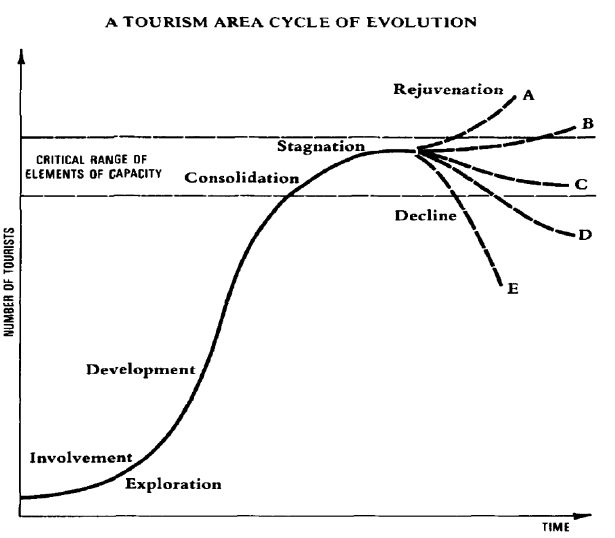The 6 phases of a tourist destination’s life cycle

Since the mid-20th century, thanks to factors such as the emergence of commercial flights, higher household incomes and the regularization of paid vacations, among others, tourism has become a mass phenomenon.
Until then, this was an activity that had been carried out empirically, causing some tourism projects to become unsustainable over time. In order to have a guide that would allow planners and developers to anticipate problems and create alternative or contingency plans, the need to create a model with the different stages of development of a tourist destination was considered.
The great beneficiaries of this model on the phases through which a tourist destination moves through are the tour operators or wholesalers, who determine how to sell a tourist package taking into account the specific phase of a destination’s development cycle.
There are many examples of wholesale travel agencies that analyze, research and apply these studies to increase the profitability of their products.
Understanding the tourism life cycle is crucial for stakeholders in the tourism industry. This concept not only helps in recognizing the current stage of a destination but also in strategizing for sustainable growth and development. As tourism evolves from a niche activity to a mass phenomenon, recognizing each phase within the tourism life cycle becomes a pivotal tool for effective management and planning.
What is the life cycle of a tourist destination according to Butler?
To answer this question, Richard Butler, Emeritus Professor at the Strathclyde Business School in Glasgow, created the Tourism Area Life Cycle (TALC) in 1980. In it, he essentially equates the evolution of destinations with that of products or services.
Butler seeks to demonstrate that tourism is not a static process, but that it evolves or declines according to factors such as destination discovery, visitor flow, support from authorities, the relationship between tourists and locals, infrastructure, etc.
To create his model, Butler used a number of theories related to other fields, such as sociology, biology and the life cycle of products in international commerce. The TALC has become a widely used tool as a theoretical foundation for research and analysis of the tourism sector.
Phases
According to Butler’s model, tourism destinations go through six evolutionary phases, although it is important to mention that not all destinations invariably go through each of them.
Exploration
In this first phase the destination receives few visitors, lured by natural attractions, such as pristine beaches; or by its culture, such as handicrafts or ethnic groups. It is precisely the lack of infrastructure that attracts the attention of the first tourists. The physical environment and its population are little affected by the presence of visitors, and the economic benefits are limited. There is usually a positive relationship between locals and tourists.
Involvement
In this phase, local people start businesses aimed at tourists, such as guesthouses, restaurants or tours. Investors show interest in developing future projects.
Governments are pressured by the need to develop tourism infrastructure. It begins with the promotion of the destination, which gives rise to the phenomenon of seasonality.
Development
The flow of visitors increases, as well as the digital promotion of the destination. Tour operators and tourism promoters take the opportunity to launch their promotional campaigns advertising the destination on travel agencies’ social networks in order to reach a larger target audience. At this stage, infrastructure grows, especially related to transportation. Natural and cultural attractions may become less important due to the emergence of new artificial attractions.
Occasionally, control of the tourism market passes from local hands to external companies. The standard of living of the inhabitants generally improves, however, the relationship they have with tourists can become strained.
The development phase in the tourism life cycle is a critical turning point, where effective management can significantly influence the future trajectory of a destination. At this juncture, understanding the intricacies of the tourism life cycle allows for the implementation of strategies that balance growth with sustainability. This ensures that the destination remains attractive and viable for future visitors while preserving its natural and cultural assets.
Consolidation
During this stage growth slows, but continues to rise. This may be intentional, to preserve the exclusivity of services, or not.
Tourism becomes fundamental for the economy of the area, generally being its main source of income. The aim is to increase the stay of visitors, their per capita expenditure and to deseasonalize visits.
Due to foreign companies setting up in the region, there is a drain of capital. Other negative effects may be felt, such as wear and tear on the infrastructure and dissatisfaction of the local population with tourism.
Stagnation
During this phase, tourism demand begins to decline and stagnate. The destination is no longer fashionable, so an alternative or conservative market is sought. Economic, environmental and social problems arise.
As destinations reach the stagnation phase and face challenges in attracting new visitors, harnessing the power of data and insights is essential.
Dive into our in-depth analysis on leveraging Google Travel Insights for strategic tourism growth and innovation, where we explore the transformative power of data in the tourism industry.
Decline or rejuvenation
In the last stage there are two scenarios: decline, where the destination loses affluence and cannot compete with other destinations that are in earlier stages. When this happens, the tourism infrastructure is usually put to another use.
This decline is usually gradual, but can also occur abruptly and unexpectedly due to external events (for example, the COVID-19 crisis in 2020, considered by the UNWTO as the worst year in history for tourism).
Another course that a destination can take after stagnation is rejuvenation, where efforts are combined to shift the destination’s focus, become more sustainable and target other markets.
Life cycle graph of a tourism destination
Butler’s graph is a linear model in which the different stages are plotted along X and Y axes, representing the number of visitors and time, respectively.

Example
A great number of tourist sites have been analyzed according to the Butler model, such is the case with a 2009 study carried out by Carlos Rogelio Virgen Aguilar on Puerto Vallarta. Broadly speaking, these were his conclusions:
Several factors influenced the discovery of Puerto Vallarta, undoubtedly an important one was that it became the location for the 1964 film “The Night of the Iguana”, directed by John Houston.
In the following years Puerto Vallarta experienced a boom from 2,687 hotel units in 1975 to 10,029 in 1992. An international airport was built in 1970 and the tourist infrastructure was improved.
After this stage, where the average annual rate was 15.2%, growth slowed down and even decreased, but showed a slight increase from 2001 to 2005, with condominiums being the predominant choice (non-hotel offering).
After 2005, no new attractions were created to attract a greater number of tourists, nor did they seek to increase per capita spending. Undoubtedly, the offer of condominiums affected the hotel sector, while the neighboring destination, Nuevo Vallarta, attracts a large part of the region’s tourism.
Conclusion
Butler’s model is an important analysis tool that allows for the future planning of a tourist destination and the development of action plans that will allow it to reinvent itself once it goes beyond the consolidation phase.
As we wrap up our discussion on the life cycle of tourist destinations, understanding the crucial role of expert management in these phases is paramount. Delve into our dedicated exploration to grasp the full scope of the benefits of a travel management company, where we dissect their pivotal role and offer a comprehensive view of their operational strategies and advantages.
Subscribe to
our newsletter
Yay! You are now
subscribed to our
newsletter
Mize is the leading hotel booking optimization solution in the world. With over 170 partners using our fintech products, Mize creates new extra profit for the hotel booking industry using its fully automated proprietary technology and has generated hundreds of millions of dollars in revenue across its suite of products for its partners. Mize was founded in 2016 with its headquarters in Tel Aviv and offices worldwide.
Related Posts

Opening Up to New Markets While Maintaining the Brand
8 min. Case study of adapting the Mize brand for the East Asia market Making a cultural adjustment – finding the balance between global and local The process of growing globally can be very exciting and, at the same time, challenging. Although you are bringing more or less the same products and vision, the way […]

Travel Niche: What It Is, How to Leverage It, Case Studies & More
14 min. Niche travel is one of the few travel sectors that have maintained their pre-COVID market growth. By catering to specific traveler segments, niche travel developed products around adventure travel, eco-tourism, LGBTQ+ travel, and wellness retreats. Take adventure tourism as only one segment of the niche tourism market. In 2021, it reached 288 billion […]

4 Lessons You Can Learn From the Best Tourism Campaigns
13 min. Businesses in the tourism industry rely heavily on marketing to generate leads and boost conversion rates. Tourism marketing is as old as tourism itself – and it always reflects the destination and service benefits relevant to the current travelers’ needs, wants, and expectations. In other words, tourism campaigns must constantly move forward, and […]
